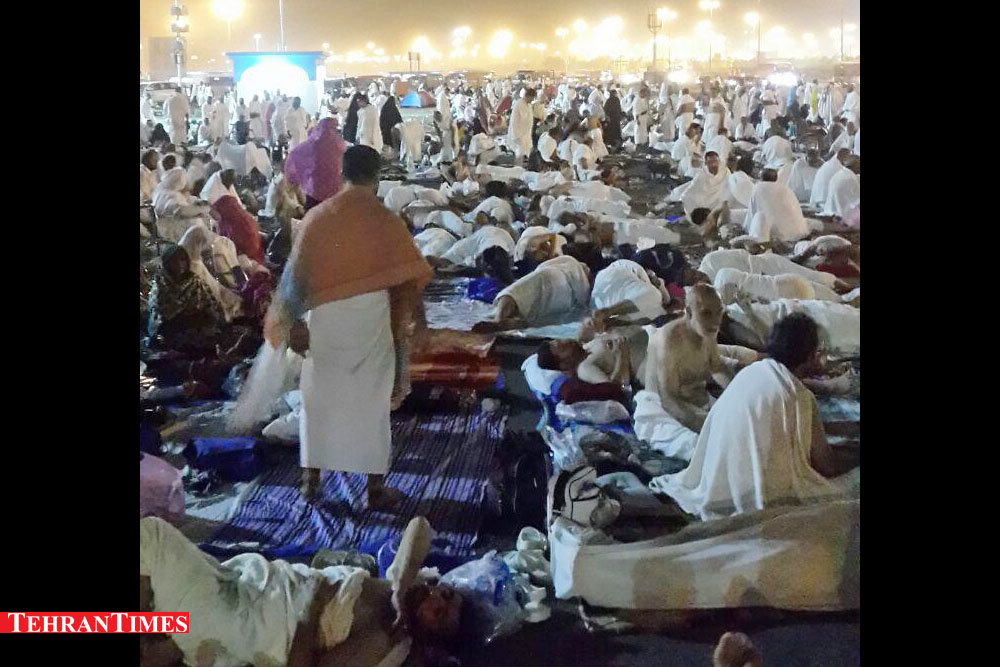Firsthand witness says how 2015 Hajj turned tragic

There were hundreds but thousands of corpses piled up on top of each other in the sizzling, scorching heat of the Mina.
These days Hajjis, the Muslims who have successfully completed Hajj to Mecca, are returning home after finishing their pilgrimage in Saudi Arabia.
It was exactly these days last year when some of the pilgrims’ families went to greet the coffin of their loved ones tearfully from the Hajj pilgrimage.
Masoud Ashtiani had firsthand experience in the Mina last year witnessing the incident. The following is Ashtiani’s memoir of the disastrous stampede in Mina last year.

Masoud Ashtiani (first from left)
It was a “disaster” to say the least; the only word that can partially describe the depth of the accident. Half-dead bodies laid on the ground like fish just taken from the water or caught in fishing nets. They would show signs of movement, but no one was there to save them. There was no way to rescue the victims, there were too many of them. You can save one fish and throw it back to the sea, take the second and do the same, the third fish, the fourth …
There were hundreds but thousands of corpses piled up on top of each other in the sizzling, scorching heat of the Mina.
It all began so strangely. We took the journey to Jamareh late, around 10:00. The Street 206 was so crowded that we were let out of 204 Street. We noticed the street was closed and a number of people had passed out on the ground. We couldn’t quite figure out what had happened. Since we had no previous experience of such accidents, we left the scene. After coming back from Jamareh, some women ran to us anxiously asking about their husbands’ wellbeing. Another woman would inquire about her brothers who had left early in the day but had not returned. “What was happening there? When did you leave? My father left earlier but is not back yet,” another woman asked us ... Their anxiety had not turned to panic yet. We told them it was nothing, they would return. The roads were really congested and most probably they were stuck in a crowd. They would leave us with a quick thank-you and went their way.
Not knowing, once we returned to our tents which was across from the Iranian hajj office, we found out that those people were dead. They announced the death of 80 Iranians, but the number was on the rise. “Another 20 people is added to the death toll, 50, 100”… The death toll added up as we got closer to the evening just like an hourglass.
Who’s to blame here? The blame largely goes to the undisciplined pilgrims who wanted to perform their religious duties as quickly as possible. Well, of course, maybe they were right. Bad weather conditions, thirst, exhaustion of the trip, and ill-equipped tents all had played a role in making Hajjis restless, rushing to end the Jamareh ritual faster while still early in the day, not to mention the group’s convoy who had not instructed the group members to encounter accidents of such.
Having said that, the Saudis’ malice and incompetence was a contributing factor, as well.
They have been organizing the Hajj pilgrimage for a very long time but have acquired no proper skill for crisis management to avoid such disasters.
It was just bad; crowded environment, bad weather, hot water running through pipes, so hot that we would feel worse showering. Our water tanks was leaking. Everything was in its primitive form. They really weren’t able to manage the Hajjis for a few days, why?
The process of picking up the corpses and identifying bodies were sorrowful as you watched on TV; it was a heart-wrenching scene. Helpless women were looking for the body of their husbands everywhere. They would place all dead bodies at ME’AISEM and would not allow access to no one.
Some eight people died in our convoy though our head of convoy had already warned us of not leaving the site due to congestion. This is when an experienced leader is distinguished from others.
The death toll was much higher in other convoys, reaching 50 in some cases. It is unbelievable but many died because of a drop in blood pressure and/or dehydration. Had the Saudis predicted such problems, such disaster wouldn’t have taken place.




Photo and Video by: Masoud Ashtiani
Edited By: Marjan Golpira
